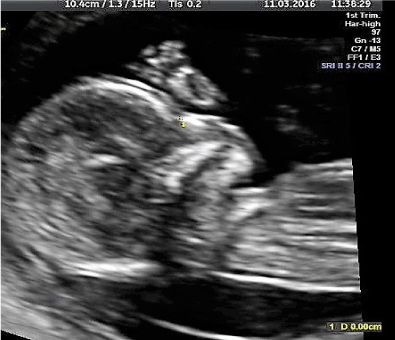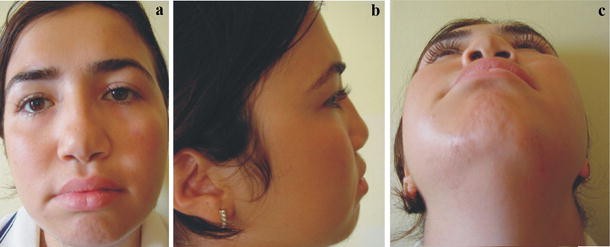
Keutel syndrome is characterized by calcification and/or ossification of the cartilage in the external ears, nose, larynx, epiglottis, thyroid, trachea, ala nasi, and ribs this syndrome also presents with peripheral pulmonary stenosis, sensory hearing loss, and borderline-to-mild mental retardation. Binder syndrome or maxillonasal dysplasia is an uncommon developmental anomaly affecting primarily the anterior part of the maxilla and nasal complex. Fabrice Cuillier, MD, Mardamootoo D., Cartault F., Alessandri J.L. Rudiger syndrome presents with short digits and talipes. Binder syndrome with brachytelephalangy secondary to maternal vitamin K deficiency.

Apert syndrome is characterized by irregular craniosynostosis, short occipital-frontal diameter, flat occiput, ventriculomegaly, and syndactyly. Crouzon syndrome is associated with craniosynostosis and short occipital-frontal diameter. Maxillonasal dysplasia or Binders syndrome is an uncommon though easily recognizable congenital condition characterized by a retruded mid-face with an. The characteristic findings are a failure of development in the premaxillary area with associated deformities of the nasal skeleton and the overlying soft tissues. Binders Syndrome also known as Maxillo-Nasal Dysplasia is a developmental disorder primarily affecting the anterior part of the maxilla and nasal complex (nose and jaw). Definition : Binder syndrome or maxillo-nasal dysplasia or maxillo-nasal dysostosis is an uncommon developmental anomaly affecting primarily the anterior part of the maxilla and nasal complex. Management of the syndrome varies with the severity of facial anomalies present and association with other anomalies. Aarskog syndrome is associated with brachycephaly and clinodactyly of the 5th finger. Binder syndrome or maxillonasal dysplasia is an uncommon developmental anomaly affecting primarily the anterior part of the maxilla and nasal complex. Binder’s syndrome or maxillonasal dysplasia is a rare clinical entity characterized by abnormal development (dysplasia) of naso maxillary region. Robinow syndrome is associated with short forearms, clinodactyly, and macrocephaly.

Also called nasomaxillary hypoplasia or maxilla-facial dysplasia, the condition results in undergrowth of the central face and may include elements of the nose and upper jaw. Chondrodysplasia punctata is also associated with scoliosis and asymmetrical shortening of the limbs. Binder syndrome is a rare congenital disease affecting the face. Binder syndrome should be suspected when prenatal ultrasound identifies a low flat nasal bridge. The differential diagnosis of Binder syndrome includes other facial disorders, most of which are usually associated with genetic disorders (Table 12.1).


 0 kommentar(er)
0 kommentar(er)
